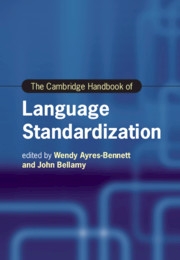Book contents
- The Cambridge Handbook of Language Standardization
- cambridge handbooks in language and linguistics
- The Cambridge Handbook of Language Standardization
- Copyright page
- Contents
- Figures
- Tables
- Contributors
- Introduction
- Part I Revisiting Models and Theories of Language Standardization
- Part II Legitimacy, Authority and the Written Form
- Part III Norms, Literacy and Education
- Part IV Beyond the National
- Part V Standardization in Late Modernity
- Name Index
- Subject Index
- References
Introduction
Published online by Cambridge University Press: 01 July 2021
- The Cambridge Handbook of Language Standardization
- cambridge handbooks in language and linguistics
- The Cambridge Handbook of Language Standardization
- Copyright page
- Contents
- Figures
- Tables
- Contributors
- Introduction
- Part I Revisiting Models and Theories of Language Standardization
- Part II Legitimacy, Authority and the Written Form
- Part III Norms, Literacy and Education
- Part IV Beyond the National
- Part V Standardization in Late Modernity
- Name Index
- Subject Index
- References
Summary
Linguistic standardization has long preoccupied researchers from different sub-disciplines of linguistics, including historical, applied and sociolinguists, as well as those working on language policy. This Introduction outlines some of the key issues that run through the literature on standardization, as well as the chapters in this volume, and on which there has not always been a clear consensus. These include terminological issues, the relationship between written and spoken standards, the variability of the standard both synchronically and diachronically and the authorities on which standard languages are based. We consider how traditional models are being reviewed and challenged by opening up the scope and type of case studies to embrace multilingual situations, minoritized languages and transnational contexts. Traditional standardization narratives are also being questioned through consideration of standardization ‘from below’. Standard languages play an important role in the legal and educational systems, bringing opportunities but also challenges. We conclude by discussing a number of symptoms of the increased ‘democratization’ of standardization, such as online and digital channels, and the emergence of ‘unofficial spoken standards’.
Keywords
- Type
- Chapter
- Information
- The Cambridge Handbook of Language Standardization , pp. 1 - 24Publisher: Cambridge University PressPrint publication year: 2021



